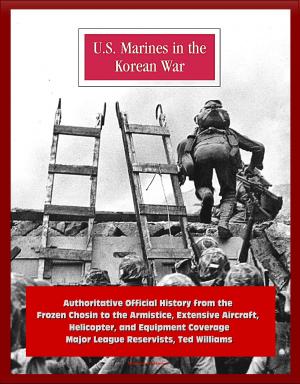United States Army in World War II: The European Theater of Operations: The Supreme Command - SHAEF, D-Day Invasion, Pursuit to the Seine, Rhine, Fighting in the North, Drive to the Elbe, Surrender
Nonfiction, History, Military, World War II| Author: | Progressive Management | ISBN: | 9781310828607 |
| Publisher: | Progressive Management | Publication: | November 19, 2014 |
| Imprint: | Smashwords Edition | Language: | English |
| Author: | Progressive Management |
| ISBN: | 9781310828607 |
| Publisher: | Progressive Management |
| Publication: | November 19, 2014 |
| Imprint: | Smashwords Edition |
| Language: | English |
This is an extraordinary history of the Supreme Headquarters of World War II, telling the important stories of the commanders and decisions responsible for defeating Nazi Germany. This volume tells the story of the Supreme Headquarters of that Allied Expeditionary Force which seized a foothold on the German-held shores of western Europe in 1944 and which, by the following year, had completed the liberation of all western Europe. This is a history of coalition warfare. It is focused upon the agency in which the decisions of governments were translated into orders, and upon the decisions of General Eisenhower, the Supreme Commander, Allied Expeditionary Force. The narrative describes the plans and recounts the events, controversial or otherwise, leading up to the creation of the Supreme Command and the choice of a Supreme Commander for the cross-Channel attack. It follows the history of this great command to the surrender of Germany. It is the history not only of the decisions that led to victory, but of the discussions, debates, conferences and compromises that preceded decisions. Controversy was inevitable in an undertaking that required the subordination of national interests to the common good. The author does not gloss over the conflicts that arose between allied nations or individuals. The picture that emerges from these pages is one of discussion and argument, but nevertheless one of teamwork. Differences of opinion and the discussion incident thereto are often the price of sound decisions.
CHAPTER I - THE SUPREME COMMANDER * The Selection of the Supreme Commander * The New Commander * CHAPTER II - THE COALITION COMMAND * Heads of Governments * Combined Chiefs of Staff * The Supreme Commander and His Subordinates * The Organization of the Subordinate Commands * The Supreme Commander's Directive * CHAPTER III - THE NATURE OF SHAEF * Contributions of AFHQ * Contributions of COSSAC * The Chief Deputies * CHAPTER IV - THE MACHINERY OF SHAEF * The Powers Reserved to SHAEF * The Operations Division * The Intelligence Division * Administration * Civil Affairs * Publicity and Psychological Warfare * The Special Staff Divisions * Political Officers * Committees * Locations of SHAEF * CHAPTER V - PLANNING BEFORE SHAEF * Early Background * Allied Planning and Preparation in 1943 * The COSSAC Plans * CHAPTER VI - SHAEF REVISES PLANS FOR THE ATTACK * Strengthening and Widening the Assault and the Postponement of ANVIL * Increase of Airborne Units in the Assault * The Revised Plan * CHAPTER VII - SHAEF'S AIR PROBLEMS, JANUARY-JUNE 1944 * Problems of Command * Railway Bombing Plan * CROSSBOW * Effect of the Air Program * CHAPTER VIII - RELATIONS WITH THE OCCUPIED COUNTRIES * Allied Liaison Machinery * Civil Affairs Agreements * Troubled Relations With the French Committee * CHAPTER IX - FINAL PREPARATIONS FOR THE INVASION * Intensified Air Efforts Against the Enemy * Propaganda Efforts Against the Enemy * Security for the Operation * The Patton Episode * Exercises and Maneuvers * The Decision To Go * CHAPTER X - D DAY TO THE BREAKOUT * Unfolding of the Grand Design * The Enemy * Allied Command * The Battle for Caen * CHAPTER XI - THE BREAKOUT AND PURSUIT TO THE SEINE * The Allied Situation in Late July * The German Situation * Plans for the Breakout * The COBRA Operation * Hitler Outlines His Plan * Eisenhower Prepares for Action * The Mortain Counterattack * Closing the Falaise Gap * Withdrawal to the Seine * CHAPTER XII - THE CAMPAIGN IN SOUTHERN FRANCE * The Second Phase of the ANVIL Controversy * The Landings and the Advance * CHAPTER XIII - RELATIONS WITH THE FRENCH, JUNE-SEPTEMBER 1944* more.
This is an extraordinary history of the Supreme Headquarters of World War II, telling the important stories of the commanders and decisions responsible for defeating Nazi Germany. This volume tells the story of the Supreme Headquarters of that Allied Expeditionary Force which seized a foothold on the German-held shores of western Europe in 1944 and which, by the following year, had completed the liberation of all western Europe. This is a history of coalition warfare. It is focused upon the agency in which the decisions of governments were translated into orders, and upon the decisions of General Eisenhower, the Supreme Commander, Allied Expeditionary Force. The narrative describes the plans and recounts the events, controversial or otherwise, leading up to the creation of the Supreme Command and the choice of a Supreme Commander for the cross-Channel attack. It follows the history of this great command to the surrender of Germany. It is the history not only of the decisions that led to victory, but of the discussions, debates, conferences and compromises that preceded decisions. Controversy was inevitable in an undertaking that required the subordination of national interests to the common good. The author does not gloss over the conflicts that arose between allied nations or individuals. The picture that emerges from these pages is one of discussion and argument, but nevertheless one of teamwork. Differences of opinion and the discussion incident thereto are often the price of sound decisions.
CHAPTER I - THE SUPREME COMMANDER * The Selection of the Supreme Commander * The New Commander * CHAPTER II - THE COALITION COMMAND * Heads of Governments * Combined Chiefs of Staff * The Supreme Commander and His Subordinates * The Organization of the Subordinate Commands * The Supreme Commander's Directive * CHAPTER III - THE NATURE OF SHAEF * Contributions of AFHQ * Contributions of COSSAC * The Chief Deputies * CHAPTER IV - THE MACHINERY OF SHAEF * The Powers Reserved to SHAEF * The Operations Division * The Intelligence Division * Administration * Civil Affairs * Publicity and Psychological Warfare * The Special Staff Divisions * Political Officers * Committees * Locations of SHAEF * CHAPTER V - PLANNING BEFORE SHAEF * Early Background * Allied Planning and Preparation in 1943 * The COSSAC Plans * CHAPTER VI - SHAEF REVISES PLANS FOR THE ATTACK * Strengthening and Widening the Assault and the Postponement of ANVIL * Increase of Airborne Units in the Assault * The Revised Plan * CHAPTER VII - SHAEF'S AIR PROBLEMS, JANUARY-JUNE 1944 * Problems of Command * Railway Bombing Plan * CROSSBOW * Effect of the Air Program * CHAPTER VIII - RELATIONS WITH THE OCCUPIED COUNTRIES * Allied Liaison Machinery * Civil Affairs Agreements * Troubled Relations With the French Committee * CHAPTER IX - FINAL PREPARATIONS FOR THE INVASION * Intensified Air Efforts Against the Enemy * Propaganda Efforts Against the Enemy * Security for the Operation * The Patton Episode * Exercises and Maneuvers * The Decision To Go * CHAPTER X - D DAY TO THE BREAKOUT * Unfolding of the Grand Design * The Enemy * Allied Command * The Battle for Caen * CHAPTER XI - THE BREAKOUT AND PURSUIT TO THE SEINE * The Allied Situation in Late July * The German Situation * Plans for the Breakout * The COBRA Operation * Hitler Outlines His Plan * Eisenhower Prepares for Action * The Mortain Counterattack * Closing the Falaise Gap * Withdrawal to the Seine * CHAPTER XII - THE CAMPAIGN IN SOUTHERN FRANCE * The Second Phase of the ANVIL Controversy * The Landings and the Advance * CHAPTER XIII - RELATIONS WITH THE FRENCH, JUNE-SEPTEMBER 1944* more.















